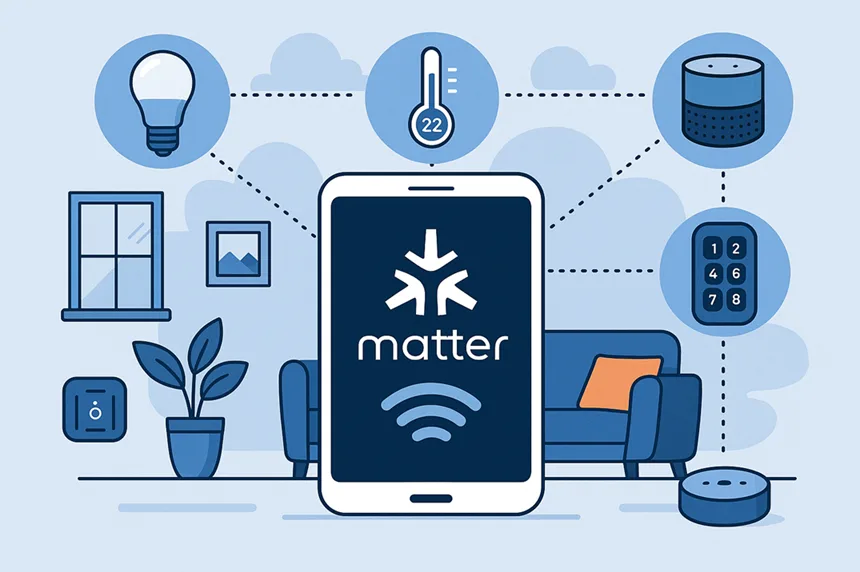The Internet of Things has matured from curious gadgets into an infrastructure that touches daily life: thermostats, locks, lights, fridges, vacuums, and air monitors—each with its own app, setup routine, and quirks. In that fragmented world, the Matter smart home standard arrived with a simple promise: make devices from different makers work together reliably, locally, and securely.
In 2025, that promise feels more attainable than it did at Matter’s 2022 launch, because the specification has evolved (notably through Matter 1.4 and follow-on refinements) and because manufacturers and platform owners have steadily increased certification and firmware updates.
What changed is not a single dramatic pivot but a sequence of fixes and industry coordination. Matter’s enhancements around Thread networking, multi-admin support, and improved router integration reduce the classic reasons smart homes break: incompatible pairing flows, duplicate device islands, and excessive cloud dependence. For consumers, that can mean shorter setups, fewer hubs, and devices that remain responsive even if the internet goes away. For professionals, from integrators to product teams, Matter narrows the set of behaviours they must design for—an operational simplification that encourages wider adoption. Recent specification patches (including Matter 1.4.2) emphasise real-world reliability and quieter, more efficient reporting for battery devices—small changes that compound into better everyday experiences.
- Matter 1.4, Thread and Home Routers
- How Interoperability Looks: Brands Supporting Matter
- Case Studies
- Matter Certification & Trust
- Edge Computing, Thread Adoption, and the Declining Cloud Dependency
- Matter adoption 2025
- Business implications: what professionals should do
- Challenges and what's still missing
- FAQs
- Conclusion
Matter 1.4, Thread and Home Routers
Matter is an application layer standard that can run over Thread, Wi-Fi, or Ethernet. The important shift in 2024–2025 has been the arrival of extended device classes (energy management, HVAC, home routers) and router/access point specifications that make network handoffs and border-router interactions more predictable. That reduces “multi-router chaos,” where different brands accidentally fragment a Thread mesh.
Matter 1.4 and 1.4.2: These updates introduced enhanced multi-admin behaviour (so more than one platform can manage devices), a spec for certifiable home routers, and optimisations for device reporting frequency to cut unnecessary chatter and preserve battery life. The CSA’s official notes explain that these changes are intended to make Matter scale better as the number of devices per household grows.
How Interoperability Looks: Brands Supporting Matter
Interoperability is not binary. There are three practical categories today:
- Native Matter devices that have the radios and firmware to join a Matter network via Thread or Wi-Fi without translation layers.
- Bridge-supported devices, where the manufacturer supplies a hub or bridge that exposes older products to Matter. This allows a long device tail to remain useful.
- Partial support where a device is Matter-aware for basic control but continues to require the vendor app for advanced features (custom light effects, deep appliance controls).
Case Studies
Philips Hue:
Signify has been careful to preserve Hue’s advanced scene and dynamic effect capabilities while updating its Bridge and new bulbs to support Matter where possible; some older bulbs still need Bridge translation for full functionality. That pragmatic path preserves user value while increasing cross-platform interoperability.
Aqara (CES / 2025):
Aqara expanded Matter compatibility to dozens of device types and introduced touchscreen controllers that act as centralised control surfaces. Aqara’s approach combines bridging for legacy Zigbee devices with Matter controllers and Thread border router functionality for newer gear—an example of how hybrid strategies accelerate adoption while protecting existing installed bases.
Matter Certification & Trust
One reason organisations push for Matter is privacy: local control (devices operating locally rather than in the cloud) and mandatory secure onboarding procedures reduce attack surfaces and reliance on third-party servers. The CSA’s certification program and distributed compliance approaches aim to give consumers confidence that a product labelled “Matter certified” meets a baseline of behaviour.
Edge Computing, Thread Adoption, and the Declining Cloud Dependency
Thread mesh networks and the rise of Thread-capable border routers (often built into smart speakers and hubs) enable low-latency, resilient local networks. Edge processing trends—doing more inference and control locally—reduce privacy exposure and latency for critical automations (e.g., door locks, presence detection). Analysts expect edge compute growth to continue through 2025 and beyond as more SoCs include the necessary networking stacks.
Matter adoption 2025
- Independent device directories list thousands of Matter-compatible or Bridge-eligible products; however, the count is conservative because many bridged devices are not listed individually.
- Industry summaries suggest increasing adoption of Matter 1.2/1.4 families; independent trackers estimated significant upticks in 2025 as firmware and hardware shipments catch up.
Business implications: what professionals should do
- Installers should learn to verify Matter certification and Thread border router behaviour, and to communicate bridge vs native support clearly to customers.
- Manufacturers must decide whether to retrofit legacy devices via bridges or invest in Thread-capable hardware for future SKUs. Hybrid strategies (bridges + incremental native releases) are common.
- Enterprise IoT teams should treat Matter as a smart-home standard with expanding device classes; for building-scale deployments, integrate Matter-aware gateways into building management systems.
Challenges and what’s still missing
- Feature parity gaps: Matter covers core functions, but some advanced device behaviours stay in vendor apps for now (dynamic lighting effects, appliance-specific menus).
- Update lag: Devices in the field may need firmware updates that manufacturers must prioritize.
- User education: Consumers must learn to check certification and to understand what a Bridge does versus native support.
FAQs
Conclusion
The Matter smart home initiative is not an overnight revolution but a meaningful course correction for the IoT industry. By establishing a widely adopted application layer that works across Thread, Wi-Fi, and Ethernet—and by iterating toward better router integration, multi-admin features, and energy-efficient reporting—Matter is reducing the friction that once made smart homes fragile and confusing. For consumers, the practical payoff will be fewer apps to juggle, more reliable local automations, and improved privacy choices. For manufacturers and integrators, Matter reduces complexity around cross-platform support and lets product teams focus on differentiated features rather than plumbing.
Adoption will keep happening slowly: you can expect more devices made for Thread, updates for existing hubs, and mixed solutions that work with old systems while also helping the industry move ahead. The most pragmatic path for anyone building, buying, or installing IoT today is to prioritize Matter-certified devices, verify whether features are native or bridge-dependent, and favour platforms that clearly document Matter versions and router/border-router behaviour. Over time, Matter’s steady technical improvements and broad industry backing should make connected living more dependable, private, and useful for a wider audience.


